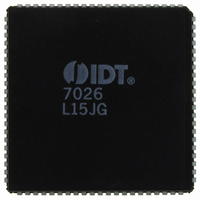IDT7026L15JG IDT, Integrated Device Technology Inc, IDT7026L15JG Datasheet - Page 17

IDT7026L15JG
Manufacturer Part Number
IDT7026L15JG
Description
IC SRAM 256KBIT 15NS 84PLCC
Manufacturer
IDT, Integrated Device Technology Inc
Datasheet
1.IDT7026L15JG.pdf
(18 pages)
Specifications of IDT7026L15JG
Format - Memory
RAM
Memory Type
SRAM - Dual Port, Asynchronous
Memory Size
256K (16K x 16)
Speed
15ns
Interface
Parallel
Voltage - Supply
4.5 V ~ 5.5 V
Operating Temperature
0°C ~ 70°C
Package / Case
84-PLCC
Lead Free Status / RoHS Status
Lead free / RoHS Compliant
Other names
7026L15JG
800-1366
800-1366-5
800-1366
800-1366
800-1366-5
800-1366
Available stocks
Company
Part Number
Manufacturer
Quantity
Price
Company:
Part Number:
IDT7026L15JG
Manufacturer:
IDT Integrated Device Technolo
Quantity:
135
Company:
Part Number:
IDT7026L15JG
Manufacturer:
IDT, Integrated Device Technology Inc
Quantity:
10 000
semaphores alone do not guarantee that access to a resource is secure.
As with any powerful programming technique, if semaphores are misused
or misinterpreted, a software error can easily happen.
via the initialization program at power-up. Since any semaphore request
flag which contains a zero must be reset to a one, all semaphores on both
sides should have a one written into them at initialization from both sides
to assure that they will be free when needed.
Using Semaphores—Some Examples
as resource markers for the IDT7026’s Dual-Port RAM. Say the 16K x
16 RAM was to be divided into two 8K x 16 blocks which were to be
dedicated at any one time to servicing either the left or right port. Semaphore
0 could be used to indicate the side which would control the lower section
of memory, and Semaphore 1 could be defined as the indicator for the
upper section of memory.
the processor on the left port could write and then read a zero in to
Semaphore 0. If this task were successfully completed (a zero was
read back rather than a one), the left processor would assume control
of the lower 8K. Meanwhile the right processor was attempting to gain
control of the resource after the left processor, it would read back a one
in response to the zero it had attempted to write into Semaphore 0. At this
point, the software could choose to try and gain control of the second 8K
SEMAPHORE
WRITE
IDT7026S/L
High-Speed 16K x 16 Dual-Port Static RAM
L PORT
Initialization of the semaphores is not automatic and must be handled
Perhaps the simplest application of semaphores is their application
To take a resource, in this example the lower 8K of Dual-Port RAM,
D
REQUEST FLIP FLOP
0
READ
SEMAPHORE
D
Figure 4. IDT7026 Semaphore Logic
Q
REQUEST FLIP FLOP
SEMAPHORE
Q
D
SEMAPHORE
READ
R PORT
D
WRITE
2939 drw 17
0
6.42
,
17
section by writing, then reading a zero into Semaphore 1. If it succeeded
in gaining control, it would lock out the left side.
Semaphore 0 and may then try to gain access to Semaphore 1. If
Semaphore 1 was still occupied by the right side, the left side could undo
its semaphore request and perform other tasks until it was able to write, then
read a zero into Semaphore 1. If the right processor performs a similar task
with Semaphore 0, this protocol would allow the two processors to swap
8K blocks of Dual-Port RAM with each other.
variable, depending upon the complexity of the software using the
semaphore flags. All eight semaphores could be used to divide the Dual-
Port RAM or other shared resources into eight parts. Semaphores can
even be assigned different meanings on different sides rather than being
given a common meaning as was shown in the example above.
interfaces where the CPU must be locked out of a section of memory during
a transfer and the I/O device cannot tolerate any wait states. With the use
of semaphores, once the two devices has determined which memory area
was “off-limits” to the CPU, both the CPU and the I/O devices could access
their assigned portions of memory continuously without any wait states.
state is available on one or both sides. Once a semaphore handshake has
been performed, both processors can access their assigned RAM
segments at full speed.
case, block arbitration is very important. For this application one processor
may be responsible for building and updating a data structure. The other
processor then reads and interprets that data structure. If the interpreting
processor reads an incomplete data structure, a major error condition may
exist. Therefore, some sort of arbitration must be used between the two
different processors. The building processor arbitrates for the block, locks
it and then is able to go in and update the data structure. When the update
is completed, the data structure block is released. This allows the
interpreting processor to come back and read the complete data structure,
thereby guaranteeing a consistent data structure.
Once the left side was finished with its task, it would write a one to
The blocks do not have to be any particular size and can even be
Semaphores are a useful form of arbitration in systems like disk
Semaphores are also useful in applications where no memory “WAIT”
Another application is in the area of complex data structures. In this
Military, Industrial and Commercial Temperature Ranges














